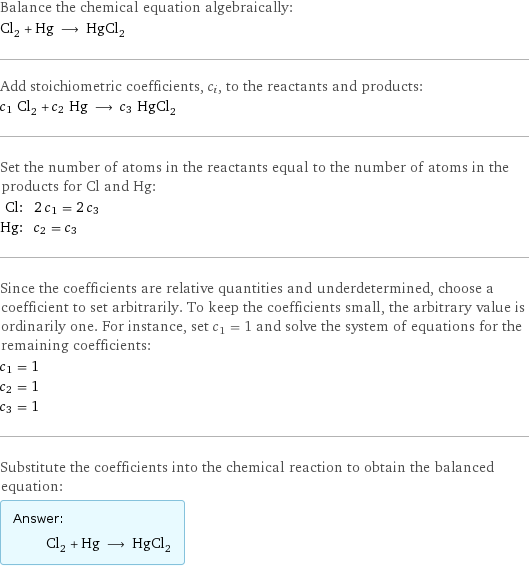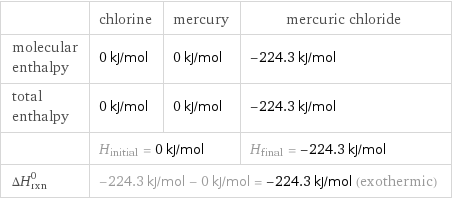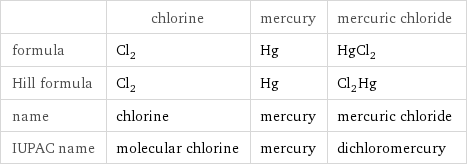Input interpretation

Cl_2 chlorine + Hg mercury ⟶ HgCl_2 mercuric chloride
Balanced equation

Balance the chemical equation algebraically: Cl_2 + Hg ⟶ HgCl_2 Add stoichiometric coefficients, c_i, to the reactants and products: c_1 Cl_2 + c_2 Hg ⟶ c_3 HgCl_2 Set the number of atoms in the reactants equal to the number of atoms in the products for Cl and Hg: Cl: | 2 c_1 = 2 c_3 Hg: | c_2 = c_3 Since the coefficients are relative quantities and underdetermined, choose a coefficient to set arbitrarily. To keep the coefficients small, the arbitrary value is ordinarily one. For instance, set c_1 = 1 and solve the system of equations for the remaining coefficients: c_1 = 1 c_2 = 1 c_3 = 1 Substitute the coefficients into the chemical reaction to obtain the balanced equation: Answer: | | Cl_2 + Hg ⟶ HgCl_2
Structures

+ ⟶
Names

chlorine + mercury ⟶ mercuric chloride
Reaction thermodynamics
Enthalpy

| chlorine | mercury | mercuric chloride molecular enthalpy | 0 kJ/mol | 0 kJ/mol | -224.3 kJ/mol total enthalpy | 0 kJ/mol | 0 kJ/mol | -224.3 kJ/mol | H_initial = 0 kJ/mol | | H_final = -224.3 kJ/mol ΔH_rxn^0 | -224.3 kJ/mol - 0 kJ/mol = -224.3 kJ/mol (exothermic) | |
Gibbs free energy

| chlorine | mercury | mercuric chloride molecular free energy | 0 kJ/mol | 0 kJ/mol | -178.6 kJ/mol total free energy | 0 kJ/mol | 0 kJ/mol | -178.6 kJ/mol | G_initial = 0 kJ/mol | | G_final = -178.6 kJ/mol ΔG_rxn^0 | -178.6 kJ/mol - 0 kJ/mol = -178.6 kJ/mol (exergonic) | |
Entropy

| chlorine | mercury | mercuric chloride molecular entropy | 223 J/(mol K) | 76 J/(mol K) | 144 J/(mol K) total entropy | 223 J/(mol K) | 76 J/(mol K) | 144 J/(mol K) | S_initial = 299 J/(mol K) | | S_final = 144 J/(mol K) ΔS_rxn^0 | 144 J/(mol K) - 299 J/(mol K) = -155 J/(mol K) (exoentropic) | |
Equilibrium constant
![Construct the equilibrium constant, K, expression for: Cl_2 + Hg ⟶ HgCl_2 Plan: • Balance the chemical equation. • Determine the stoichiometric numbers. • Assemble the activity expression for each chemical species. • Use the activity expressions to build the equilibrium constant expression. Write the balanced chemical equation: Cl_2 + Hg ⟶ HgCl_2 Assign stoichiometric numbers, ν_i, using the stoichiometric coefficients, c_i, from the balanced chemical equation in the following manner: ν_i = -c_i for reactants and ν_i = c_i for products: chemical species | c_i | ν_i Cl_2 | 1 | -1 Hg | 1 | -1 HgCl_2 | 1 | 1 Assemble the activity expressions accounting for the state of matter and ν_i: chemical species | c_i | ν_i | activity expression Cl_2 | 1 | -1 | ([Cl2])^(-1) Hg | 1 | -1 | ([Hg])^(-1) HgCl_2 | 1 | 1 | [HgCl2] The equilibrium constant symbol in the concentration basis is: K_c Mulitply the activity expressions to arrive at the K_c expression: Answer: | | K_c = ([Cl2])^(-1) ([Hg])^(-1) [HgCl2] = ([HgCl2])/([Cl2] [Hg])](../image_source/e86686105a32c3849df18041f7b8c174.png)
Construct the equilibrium constant, K, expression for: Cl_2 + Hg ⟶ HgCl_2 Plan: • Balance the chemical equation. • Determine the stoichiometric numbers. • Assemble the activity expression for each chemical species. • Use the activity expressions to build the equilibrium constant expression. Write the balanced chemical equation: Cl_2 + Hg ⟶ HgCl_2 Assign stoichiometric numbers, ν_i, using the stoichiometric coefficients, c_i, from the balanced chemical equation in the following manner: ν_i = -c_i for reactants and ν_i = c_i for products: chemical species | c_i | ν_i Cl_2 | 1 | -1 Hg | 1 | -1 HgCl_2 | 1 | 1 Assemble the activity expressions accounting for the state of matter and ν_i: chemical species | c_i | ν_i | activity expression Cl_2 | 1 | -1 | ([Cl2])^(-1) Hg | 1 | -1 | ([Hg])^(-1) HgCl_2 | 1 | 1 | [HgCl2] The equilibrium constant symbol in the concentration basis is: K_c Mulitply the activity expressions to arrive at the K_c expression: Answer: | | K_c = ([Cl2])^(-1) ([Hg])^(-1) [HgCl2] = ([HgCl2])/([Cl2] [Hg])
Rate of reaction
![Construct the rate of reaction expression for: Cl_2 + Hg ⟶ HgCl_2 Plan: • Balance the chemical equation. • Determine the stoichiometric numbers. • Assemble the rate term for each chemical species. • Write the rate of reaction expression. Write the balanced chemical equation: Cl_2 + Hg ⟶ HgCl_2 Assign stoichiometric numbers, ν_i, using the stoichiometric coefficients, c_i, from the balanced chemical equation in the following manner: ν_i = -c_i for reactants and ν_i = c_i for products: chemical species | c_i | ν_i Cl_2 | 1 | -1 Hg | 1 | -1 HgCl_2 | 1 | 1 The rate term for each chemical species, B_i, is 1/ν_i(Δ[B_i])/(Δt) where [B_i] is the amount concentration and t is time: chemical species | c_i | ν_i | rate term Cl_2 | 1 | -1 | -(Δ[Cl2])/(Δt) Hg | 1 | -1 | -(Δ[Hg])/(Δt) HgCl_2 | 1 | 1 | (Δ[HgCl2])/(Δt) (for infinitesimal rate of change, replace Δ with d) Set the rate terms equal to each other to arrive at the rate expression: Answer: | | rate = -(Δ[Cl2])/(Δt) = -(Δ[Hg])/(Δt) = (Δ[HgCl2])/(Δt) (assuming constant volume and no accumulation of intermediates or side products)](../image_source/1ac1f7c82c4f8f367b29b314aa54f22f.png)
Construct the rate of reaction expression for: Cl_2 + Hg ⟶ HgCl_2 Plan: • Balance the chemical equation. • Determine the stoichiometric numbers. • Assemble the rate term for each chemical species. • Write the rate of reaction expression. Write the balanced chemical equation: Cl_2 + Hg ⟶ HgCl_2 Assign stoichiometric numbers, ν_i, using the stoichiometric coefficients, c_i, from the balanced chemical equation in the following manner: ν_i = -c_i for reactants and ν_i = c_i for products: chemical species | c_i | ν_i Cl_2 | 1 | -1 Hg | 1 | -1 HgCl_2 | 1 | 1 The rate term for each chemical species, B_i, is 1/ν_i(Δ[B_i])/(Δt) where [B_i] is the amount concentration and t is time: chemical species | c_i | ν_i | rate term Cl_2 | 1 | -1 | -(Δ[Cl2])/(Δt) Hg | 1 | -1 | -(Δ[Hg])/(Δt) HgCl_2 | 1 | 1 | (Δ[HgCl2])/(Δt) (for infinitesimal rate of change, replace Δ with d) Set the rate terms equal to each other to arrive at the rate expression: Answer: | | rate = -(Δ[Cl2])/(Δt) = -(Δ[Hg])/(Δt) = (Δ[HgCl2])/(Δt) (assuming constant volume and no accumulation of intermediates or side products)
Chemical names and formulas

| chlorine | mercury | mercuric chloride formula | Cl_2 | Hg | HgCl_2 Hill formula | Cl_2 | Hg | Cl_2Hg name | chlorine | mercury | mercuric chloride IUPAC name | molecular chlorine | mercury | dichloromercury
Substance properties

| chlorine | mercury | mercuric chloride molar mass | 70.9 g/mol | 200.592 g/mol | 271.49 g/mol phase | gas (at STP) | liquid (at STP) | solid (at STP) melting point | -101 °C | -38.87 °C | 277 °C boiling point | -34 °C | 356.6 °C | 302 °C density | 0.003214 g/cm^3 (at 0 °C) | 13.534 g/cm^3 | 5.44 g/cm^3 solubility in water | | slightly soluble | surface tension | | 0.47 N/m | dynamic viscosity | | 0.001526 Pa s (at 25 °C) | odor | | odorless | odorless
Units
